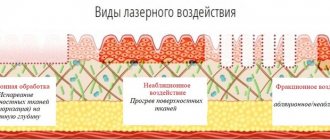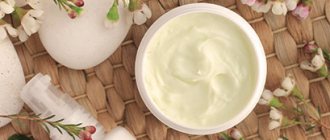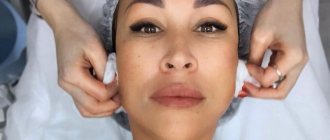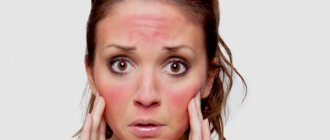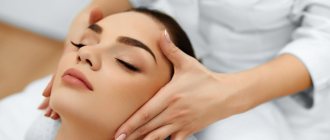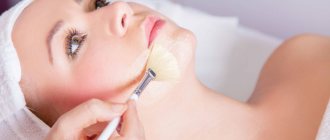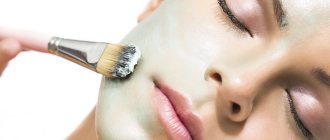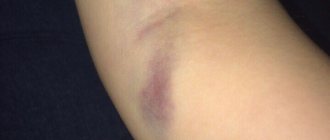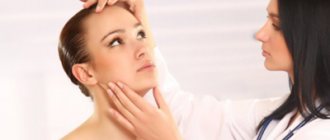- Types of peelings
- Carbon peeling
- Price
Peeling is a procedure aimed at exfoliating dead skin.
One of the most effective peeling methods is acid peeling, since this procedure cleanses various layers of the skin: superficial, superficial-medium and middle. Acid peeling effectively solves problems such as acne and post-acne, scars, wrinkles, signs of aging, age spots, decreased turgor, dull skin color. Depending on the acid included in the peeling, it can be fruit, almond, retinol, salicylic, pyruvic, glycolic, lactic, etc.
Preparing for peeling
Peeling is preceded by a preliminary consultation, during which the doctor determines the patient’s skin type and selects the most suitable type of peeling. Also during the consultation, the doctor finds out whether the patient has any possible contraindications for the upcoming cleansing procedure. Contraindications to acid peeling are:
- pregnancy and lactation;
- chronic diseases;
- oncology;
- skin diseases,
- skin damage;
- recurrent herpes.
If the patient is taking antibiotics, hormonal agents and other medications, he must inform the doctor about this, since this information must also be taken into account when choosing the type of peeling and assessing the admissibility of the procedure.
Chemical peels. Types, effects, indications, contraindications and how to avoid complications.
Chemical peeling is a controlled damage to the skin using chemical acids to correct aesthetic imperfections. The procedure allows you to solve a wide range of problems - complex treatment of rosacea, acne , as well as stretch marks, scars, wrinkles, age spots and other age-related changes.
Effects:
- the epidermis becomes thinner
- the dermis is smoothed, thickened and thickened, and becomes homogeneous.
- sebaceous pores are cleansed and narrowed
- facial tone evens out
- pigment spots lighten
- the skin is rejuvenated, looks elastic, radiant, young.
Types of chemical peeling by depth of effect:
Superficial is the effect within several keratinized layers of the skin of the epidermis.
Recommended: for young problem skin and at the stage of preparing the skin for medium peeling.
The effect is short-term.
Rehabilitation is fast
Requires frequent repeated courses (once every 14 days) for a course of 4-6 procedures.
Allows you to work.
Can be done all year round
The most popular types of acids for superficial peelings are glycolic, lactic, pyruvic, mandelic, etc.
Medium peels affect the entire stratum corneum down to the basement membrane.
They require rehabilitation and home care for a week, as there will be redness and severe peeling on the face.
Course No. 3-5 procedures, depending on the problem being solved.
The effect lasts for several months.
The most popular acids are retinol, salicylic, koic, TCA, etc.
Deep peels are the removal of the epidermis affecting the basement membrane.
Peeling is carried out under local anesthesia in a hospital setting.
Long-term rehabilitation.
Performed for deep wrinkles and scars.
Performed once in a lifetime.
For deep peeling, a phenol-based composition is used.
Indications:
- problematic skin with comedones, post-acne, acne
- rosacea
- scarring
- oily skin with enlarged pores
- dull skin color
- dark spots
- sagging, decreased elasticity of skin tone
- photoaging (exposure to intense ultraviolet radiation)
- striae
- folds, wrinkles
Chemical peels are performed from the age of 14, but only as prescribed by a doctor.
Contraindications:
- oncological diseases
- dark skin (4-6 phototype according to Fitzpatrick)
- individual intolerance to peeling components
- poor wound healing
- exacerbation of any concomitant diseases
- acute infectious-inflammatory and viral diseases
- fresh tan up to 1 month
- tendency to form hypertrophic and keloid scars
- taking photosensitizing drugs, retinoids, immunosuppressants.
Peeling stages:
Pre-peeling preparation is carried out in order to adapt the skin and even out its surface layer for better penetration of the peeling composition. Carry out 1-2 weeks before the procedure.
The peeling itself is carried out according to the protocol.
Post-peeling care helps to consolidate the effect of the procedure and avoid complications.
After the procedure there may be:
- excessive skin tightness
- redness
- swelling
- peeling
- swelling
- discomfort, tingling, burning
The procedures are performed strictly according to the protocol, by a cosmetologist or dermatologist in order to avoid complications and scar formation.
Zelenskaya I.A.
Self-preparation
Preparation for acid peeling begins several weeks before the procedure itself. The doctor informs you about the rules of the preparatory period during the preliminary consultation:
- 14 days before peeling, do not visit the solarium or sunbathe naturally, limit trips to the sauna and bathhouse;
- 7 days before peeling, do not apply scrubs containing large solid particles or acid-based cosmetic preparations; use sunscreen 35+ SPF every day;
- eliminate existing inflammatory processes on the skin;
- if there is herpes on the skin, it is necessary to use antibacterial drugs.
If peeling is carried out to eliminate pigmentation, it is recommended to start using products with a whitening effect a week before the procedure.
Protection from external influences
When planning a procedure, you should immediately create a program on how to care for your face after peeling. An obligatory point in it will be the protection of the skin, which after chemical exposure will be thinned and very susceptible to the external environment. In particular, ultraviolet radiation and sunlight. Even 5 minutes outside can cause burns or the appearance of age spots. Therefore, facial care after peeling must include sunscreen.
You should choose formulations with an SPF factor of at least 30.
Wind and low temperatures also have a negative impact. They will worsen peeling and redness. For this reason, you should carefully consider the choice of season for cosmetic procedures on the face; spring and autumn, when the sun is gentle and the air temperature is comfortable, are optimal.
Recovery period after peeling
Immediately after an acid peel, the patient may experience minor pain and itching. At this time, it is important to try to touch the skin with your hands as little as possible; do not allow it to come into contact with other surfaces (for example, a pillow). Within 24 hours, all unpleasant sensations go away on their own; to cleanse the skin, it is recommended to use cosmetics with antibacterial and soothing ingredients.
On the 3rd - 5th day after the procedure, the peeling stage begins. To speed up this process and gently cleanse the renewed skin, you can gently massage the healing areas with a soft, clean cloth. Within 2-3 weeks after peeling, it is necessary to provide the skin with broad-spectrum protection from UVB and UVA ultraviolet radiation with a total SPF of 20-30, this significantly reduces the risk of pigmentation.
Humidification programs
Care after peeling should also be aimed at restoring the water-lipid balance of the facial skin. The chemical treatment procedure itself has a negative impact on the nutrition of the epidermis, although it provides a very noticeable result: smoothes wrinkles, improves color and tone. This exfoliates the thin top layer of skin, requiring it to be moisturized to avoid drying out.
In facial care after peeling, it is worth including special products in the form of gels or fluids. Such compositions do not need to be thoroughly rubbed in, and due to their light texture, they quickly penetrate deep into the epidermal cells and nourish the skin with moisture.
Switching to balms and serums (products with denser compositions) is possible no earlier than after 3 days. It is better to choose products for sensitive skin types or those containing antioxidants and hyaluronic acid.
Advice. Before applying the cream after the peeling procedure, it is worth spraying thermal water on your face (mineral water is also suitable), it will help the skincare cosmetics absorb faster without rubbing or stretching the skin.
Causes of peeling
Exfoliation (this is another name for deep cleansing of the skin) is impossible without exfoliating dead epidermal cells. But sometimes the peeling occurs too intensely. Causes of peeling:
- Intensity of cleansing.
Peeling can be deep, medium or superficial. In the first two cases, the epidermis is especially severely injured. Therefore, the consequences are also more noticeable: redness, peeling, swelling. - Composition of the peeling product
. Lactic and malic acids are considered gentle. They do not cause intense peeling. And the use of trichloroacetic acid is more traumatic. - Individual characteristics.
Patients with drier, more sensitive skin suffer from severe flaking after a peeling session.
Types of enzymes
The most common enzymes used for cosmetic purposes include:
- bromelain - an extract from the fruits and stems of wild lemon, pineapple, papaya. Eliminates symptoms of inflammation, acne, relieves irritation, breaks down keratin, slows down hair growth, is an immunostimulant;
- papain is an extract from the peel and leaves of papaya (contained in smaller quantities in the pulp of the fruit). Intensively breaks down keratin bonds, improves metabolism, and has disinfectant and antioxidant properties.
- Travase (sutilains) - produced by the bacteria Bacillus subtilis. Loosens the intercellular substance, exfoliates dead cells, brightens melanin;
- ficin (ficin) - contains large amounts of stems and leaves of the fig tree. It has proteolytic properties, actively breaks down keratin and promotes its removal, stimulates the production of fibrillar proteins;
- pepsin is a product from the stomach mucous membranes of farm animals. Breaks down protein components into peptides;
- subtilisin is a proteolytic enzyme produced by bacteria of the genus Bacillus subtilis. Destroys even the most complex protein bonds;
- lysozyme is an enzyme of the hydrolase class, obtained from egg white. Active against a wide range of bacteria, fungi and viruses, therefore it is common as an antiseptic, immunomodulator (anti-inflammatory effect);
- actinidin (aktinidin) is a plant enzyme with a proteolytic effect, obtained from kiwi fruits. Accelerates cell renewal and prevents collagen destruction. It is distinguished by the presence of an intense rejuvenating effect.
Consequences of the procedure
Some consequences are not worth fearing. The procedure itself is a chemical burn, after which the cover begins to recover on its own. The level of collagen and the number of elastin fibers increase. New cells replace dead layers. This manifests itself in redness, peeling, burning and swelling.
Sometimes clients experience more serious reactions, which may require another visit to the dermatologist:
- Intense redness that becomes increasingly brighter and does not disappear within an acceptable recovery period.
- A watery rash indicates a violation of the procedure. Unpleasant consequences - spots, scars.
- Severe swelling, fever.
- Scars are a consequence of damage to drying crusts.
Such reactions occur if the remedy was chosen incorrectly, the specialist did not take into account contraindications or performed the session incorrectly. And also a negative reaction is sometimes provoked by the clients themselves if they do not follow the recommendations of their cosmetologist.
Recommendations from experts
To help your skin recover faster, you need to follow these rules:
- Stop exercising. Sweat can irritate damaged skin. Mechanical damage that is possible during physical activity is also dangerous.
- Stop going to the pool or sauna.
- Avoid dishes that contain a lot of salt and hot spices. Also forget about alcohol during this time. These foods increase sweating.
- Nicotine is also harmful to injured skin.
- It is better to attend events after recovery - it is important to protect yourself from sources of bacteria.
- You need peace and no stress. An organism that is under stress performs regenerative functions worse.
Before peeling, you should consult with your specialist about what kind of care is suitable after the procedure. After all, the skin of different patients reacts differently. But there are universal recommendations. These include careful moisturizing, the use of sunscreens, and the use of products with vitamin B3.
But using oily cosmetic products and scrubs is not recommended. Also, do not peel off dead skin, touch your face, apply decorative cosmetics, or wash your face with tap water.
Peeling after a cosmetic procedure should not frighten the patient. It is important to follow the advice of a cosmetologist and be patient. If peeling does not go away for more than 2 weeks, it is important to contact your cosmetologist again.
